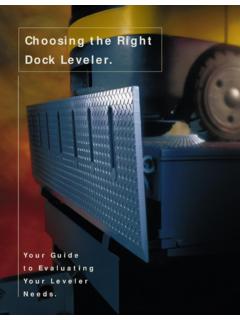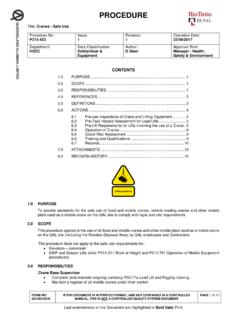Transcription of Principles For Pathogen Cross-Contamination Prevention ...
1 Principles For Pathogen Cross-Contamination Prevention (Zoning Preventive Control) and Zoning Verification Activities Environmental Monitoring Larry Cohen Kraft Foods Food Safety & Micro Principal Scientist May 18, 2011. Association and Company Participation: GMA Preventive Controls and Records Working Group. 25 companies and 54 members. AFFI Current Good Manufacturing Practices (CGMPs) Coalition Working Groups >60 companies and trade associations Guiding Principles For Building a Food Safety Plan Directional and not prescriptive. Focused on goals and outcomes as opposed to tasks. Practical to develop and maintain. Based on industry leading practices. Allow for diversity of approaches to achieve public health objective.
2 Appropriate for large and small businesses and domestic and international operations. 3. Key Points to Food Safety Plans 1. Public health will benefit from a focus on science based risk management. 2. Food safety plans are most robust if based in risk assessment. Risk assessment process is critical. 3. Rules and regulations should be goal oriented - multiple approaches can result in the same level of food safety. 4. Not all Preventive controls are critical control points (CCPs) and shall be identified as pre-requisites (PPs). 5. Preventive Controls need to be tailored to each situation, plant design, product, equipment, process and employees. 6. CGMP's topics include environmental Pathogen monitoring;. sanitation, allergen control; temperature monitoring/control and employee training.
3 Use as a supplement to existing GMP. requirements prescribed by FDA and USDA. 4. Product Design is the Foundation to Food Safety Key Objectives: and packaging that delivers safety during intended shelf life and consumer use. processes that ensure elimination or reduction of hazards to acceptable levels and an environment that prevents recontamination. based approach is necessary. 5. Product, Package, & Process Design Risk Assessment Shelf life Considerations Manufacturing Consumer/Customer Equipment and Consumer Behavior Hygienic Design Product Use Cleaning/Sanitation Consumer Preparation and Method and Storage Frequency Package Integrity Facility Structure Manufacturing conditions Traffic Flow 6 Transportation and Storage Plant Zoning Hazard Analysis Creating a Food Safety Plan requires the assessment of each individual product and process.
4 Hazard Identification Chemical, biological, & physical potential hazards: In raw materials In packaging materials During processing Environment Equipment Design Hazards Out Most effective method is to eliminate hazards if feasible Once identified, appropriate preventive controls will be determined for each hazard that is likely to occur. Verification Activities Should be Science And Risk Based Knowledge & history of products and process determine level of verification activities Dry Mix (without kill step) More stringent Raw Material verification Wet Environment or Raw/RTE Interface More stringent Environmental verification Absence of History, On- going Issues, New More stringent Finished Product Process verification 8.
5 Zoning Preventive Controls Zoning programs may be applied to facilities manufacturing or handling food products to reduce the potential for Pathogen contamination of materials and products from the environment or other materials. The definition of zoning is the division of areas of the facility based upon the barriers, cleaning procedures, employee practices and control of movement of people, equipment and materials necessary to protect products from potential hazards originating from the manufacturing environment and its surroundings . A risk assessment is critical to understanding where and how hygienic zoning programs and related controls should be employed., Zoning Principles may be evaluated at steps throughout the process including the receipt, storage, processing and packaging of food.
6 Zoning programs should focus on ensuring that appropriate controls exist to protect product, raw materials and packaging during their movement from one area to another in a facility and to protect the processing environment where exposed product and materials might become contaminated from higher risk plant areas. Zoning preventive controls focus on the interfaces and movements between areas where the microbial profile changes such as between cooked and raw product. The importance of zoning programs will vary based on the product type, design of the manufacturing process and process flow. In raw facilities where there is no targeted microbial reduction step, the need for zoning is minimal. Elements of a Zoning Preventive Program Conduct and document a risk assessment to identify areas within the facility where potential sources of Pathogen contamination exist and where exposed product must be protected from contamination .
7 Based on the outcome of the risk assessment, identify and implement controls to the address risks . Review and validate the program at a predetermined frequency. Protocol for Conducting a Zoning Assessment Level of in-process/finished product sensitivity. Based on product characteristics such as Aw, pH, formulation, finished products can be ranked based on the following criteria. pathogens may grow pathogens cannot grow, but may survive pathogens cannot grow, and may only have limited survival Protocol for Conducting a Zoning Assessment Risk assessment should include product handling during production, amount of exposure to the environment after the kill step, and other processing factors that may reduce or increase potential cross - contamination .
8 Less stringent controls may be necessary to prevent contamination before a Pathogen reduction step and more stringent controls maybe needed after the Pathogen reduction step. Assessment should evaluate consumer use and behavior and the likelihood of product abuse. Protocol for Conducting a Zoning Assessment During the risk assessment non-manufacturing areas of the facility such as refuse/recycling areas, restrooms / break rooms (when in manufacturing areas), roof accesses and emergency exits to and from processing should be considered. The risk assessment should evaluate the potential for Pathogen contamination of the product and this information used to determine the appropriate level of control required to prevent microbial contamination of the product from sources such as environmental air, compressed air, personnel, the equipment and adjacent zones.
9 Classification of Different Areas Non-manufacturing zone (still requires application of basic hygiene requirements): Areas where there is no open product. May include non-production areas such as utility rooms, offices, cafeteria/break rooms, locker rooms, laboratory, etc. Raw or limited process zone: Areas such as raw product receiving and storage, areas of product preparation that will be thermally or otherwise processed and that are known/have the potential to be contaminated and that may require controls to prevent contamination of high control zones. These zones may have dedicated employees and are physically separated from controlled zones or high control zones. Classification of Different Zones Controlled zone: Product can be exposed to the environment and the operators.
10 Good hygiene practices are implemented and air requirements are met. The controlled zone may also serve as transition from non-manufacturing or raw zone to high control zone. High control zone: Product which supports growth of the Pathogen of concern and can be exposed to the environment and/or the operators. Depending on the product, additional good hygiene practices, such as captive footwear/clothing, may be required and more stringent equipment/building sanitary design requirements may be followed. Plant Zoning Map Example Main 1st Level Entrance Offices Spare Tank rm Rm #1 Hallway Loading Intake/Receiving Dock #2. Rm Pit Tanks Dryer Fill Rm Dryer Rm Product #2. Boiler Rm Water Soft. Spare Dr Staging Op rm Heater Motors ye #2.




